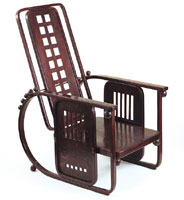home | metro silicon valley index | the arts | visual arts | review

Comfort Zone: Josef Hoffman's adjustable armchair of 1908 looks forward to the streamline tendencies of the 1920s and '30s.
Done Right
A new survey of the Arts and Crafts Movement showcases an era of exquisite design
By Michael S. Gant
THE EXCEPTIONALLY rich new show at the de Young Museum covers a lot of ground, geographically and temporally. International Arts and Crafts: William Morris to Frank Lloyd Wright, assembled by London's Victoria and Albert Museum, stretches all the way from the style's origin in England in the 1880s to its farthest ripples in Europe, the United States and Japan, all the way into World War II. The conglomeration of design principles and methods known as Arts and Crafts took off in the 1880s as a realization of the aesthetic ideas of art critic John Ruskin and all-purpose art vortex William Morris. Both men rejected the excesses and mechanized techniques of Victorian design, calling for a return to the craft traditions of the preindustrial era, when artisans created beautiful objects by hand. The movement's goals included both improvements to the artistic taste of the buying public and a liberation of workers from the soullessness of the factory.
Design movements are notoriously hard to contain. Although the Arts and Crafts Movement emphasized a simplicity and obedience to materials, Morris' creations tended toward a lush Medievalism. One example at the show, a tapestry called The Forest (done with Henry Dearle and Philip Webb), depicts a peacock, a hare and other fauna engulfed in dense curlicues of foliage that evoke the Unicorn Tapestries. The influence of Morris' taste for Gothic arts can be seen in several sumptuous samples of limited-edition luxury bookmaking from the fine presses of Doves, Ashendene and Cobden-Sanderson. C.R. Ashbee's green-glass decanter is encased in a sinuous organic swirl of silver, with an Art Nouveau-ish handle that ends in biomorphic tendrils.
In a very different vein, Philip Webb's lovely suite of unadorned blown-glass glasses draws the eye with nothing more than a few gently billowing curves. As Arts and Crafts took off on the continent, it began to diverge sharply from its British roots. Austrian designer Josef Hoffman's silverware from the early 1900s looks like full-blown Art Deco three decades in advance. His gleaming ovoid mustard pot sits on three podlike legs, looking like a space probe. His beaten-silver fruit basket of 1904—a steeply flared square container surrounded by a grid of thin bars—is so streamlined that it did double duty in a recent survey of the Art Deco movement. An earthenware vase Frank Lloyd Wright anticipates the skyscrapers of the 1930s.
What Northern Californians think of as Arts and Crafts, as still seen in some of the higher-priced bungalows in the East Bay, is primarily the work of Gustav Stickley. A canny businessman, Stickley managed to combine an artisan's eye with a marketer's mentality, producing furniture that was both exceptionally beautiful in shape, construction and patina and relatively affordable. (The irony, of course, is that today, original Stickleys, once bought from mass catalogs, are now auction-priced, and even reproductions run to thousands of dollars for chairs and bookcases.)
Stickley is well represented in the show by an entire room, featuring one of his long, low oak settles with their elegantly spaced, deeply stained back slats and arm rests; the kind of glass-front bookcase that makes bibliophiles break down in tears; four copper and amber-glass hanging-light fixtures in a Japanese mode; and a knock-out oversize table lamp with a Grueby tile base and a Tiffany leaded-glass shade. A lot of the objects on display at the show look a bit mannered a century on, but I suspect that given a choice, almost anybody in the Bay Area would want to live in a Stickley room—the perfect blend of art and craft.
International Arts and Crafts: William Morris to Frank Lloyd Wright runs through June 18 at in Herbst Exhibition Galleries at the de Young Museum, Golden Gate Park, San Francisco. Tickets are $11-$15. The museum is open Tuesday-Sunday 9:30am-5:15pm, until 8:45pm Friday. (415.750.3642)
Send a letter to the editor about this story.
|
|
|
|
|
|